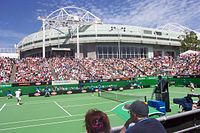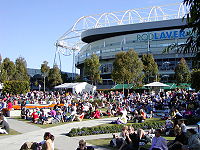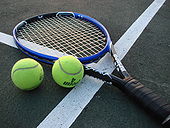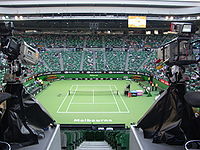- Australian Open
-
This article is about the Australian Open tennis tournament. For the Australian Open golf tournament, see Australian Open (golf). For the snooker tournament, see Australian Goldfields Open.
Australian Open 
Official web Location Melbourne, Victoria
 Australia
AustraliaVenue Melbourne Park Surface Plexicushion Prestige Men's draw 128S / 128Q / 64D Women's draw 128S / 96Q / 64D Prize money A$25,000,000 (2011)[1] Grand Slam  Australian Open
Australian Open French Open
French Open Wimbledon
Wimbledon US Open
US Open
Current  2011 Australian Open
2011 Australian OpenThe Australian Open is the only Grand Slam tennis tournament held in the southern hemisphere. The tournament was held for the first time in 1905 and was last contested on grass in 1987. Since 1972 the Australian Open has been held in Melbourne, Victoria. In 1988, the tournament became a hard court event. It is currently held at Melbourne Park. The tournament is held in Melbourne in the Australian summer, in the last fortnight of the month of January; an extreme-heat policy is put into play when temperatures reach dangerous levels.
The two main courts used in the tournament are Rod Laver Arena and Hisense Arena and feature retractable roofs, which are shut during rain or extreme heat. The Australian Open and Wimbledon are the only Grand Slam tournaments with indoor play. In 2008, the Rebound Ace surface, which had been in place for the past 20 years at Melbourne Park, was replaced by a cushioned, medium-paced,[2] acrylic surface known as Plexicushion Prestige. Roger Federer and Serena Williams are the only players to win the Australian Open on both Rebound Ace and Plexicushion Prestige. The main benefits of the new surface are better consistency and less retention of heat because of a thinner top layer. This change was accompanied by changes in the surfaces of all lead-up tournaments to the Australian Open. The change was controversial because of the new surface's similarity to DecoTurf, the surface used by the US Open.[3]
Like all other Grand Slam tournaments, there are men's and women's singles competitions; men's, women's, and mixed doubles; and junior's, wheelchair, exhibition, and legends' competitions.
The Australian Open typically has very high attendance, with the 2010 Australian Open achieving the highest ever single-day day/night attendance record for any Grand Slam tournament of 77,043 and an overall attendance of 653,860.[4]
Contents
History
The Australian Open is managed by Tennis Australia, formerly the Lawn Tennis Association of Australia (LTAA), and was first played at the Warehouseman's Cricket Ground in Melbourne in 1905. This facility is now known as Albert Reserve Tennis Centre.[5]
The tournament was first known as the Australasian Championships and then became the Australian Championships, in 1927, and the Australian Open in 1969.[6] Since 1905, the Australian Open has been staged in five Australian and two New Zealand cities as follows: Melbourne (55 times), Sydney (17 times), Adelaide (14 times), Brisbane (7 times), Perth (3 times), Christchurch (in 1906), and Hastings (in 1912).[6] In 1972, when it was decided to stage the tournament in the same city each year, the Kooyong Lawn Tennis Club was selected because Melbourne attracted the biggest patronage.[5] Though started in 1905, the tournament was not designated as being a major championship until 1924, by the International Lawn Tennis Federation (ILTF) in a 1923 meeting. The tournament committee changed the structure of the tournament to include seeding at that time.[7]
Melbourne Park (formerly Flinders Park) was constructed for the 1988 tournament to meet the demands of a tournament that had outgrown Kooyong's capacity. The move to Melbourne Park was an immediate success, with a 90 percent increase in attendance in 1988 (266,436) on the previous year at Kooyong (140,000).[8]
Because of its geographic remoteness very few foreign players entered this tournament at the beginning. In the 1920s, the trip by ship from Europe to Australia took about 45 days. The first tennis players who came by aircraft were the US Davis Cup players in November 1946.[8] Even inside the country, many players could not travel easily. When the tournament was held in Perth, no one from Victoria or New South Wales crossed by train, a distance of about 3,000 kilometres (1,900 mi) between the east and west coasts. In Christchurch in 1906, of a small field of 10 players, only two Australians attended, and the tournament was won by a New Zealander.[9]
 Margaret Court Arena at the Australian Open with the old Rebound Ace surface. Rod Laver Arena, the centre court, in the background
Margaret Court Arena at the Australian Open with the old Rebound Ace surface. Rod Laver Arena, the centre court, in the background
The first tournaments of the Australasian Championships suffered from the competition of the other Australasian tournaments. Before 1905, all Australian States and New Zealand had their own championships, the first organised in 1880 in Melbourne and called the Championship of the Colony of Victoria (later the Championship of Victoria).[10] In those years, the best two players – the Australian Norman Brookes (whose name is now written on the men's singles cup) and the New Zealander Anthony Wilding – almost did not play this tournament. Brookes came once and won in 1911, and Wilding entered and won the competition twice (1906 and 1909). Their meetings in the Victorian Championships (or at Wimbledon) helped to determine the best Australasian players. Even when the Australasian Championships were held in Hastings, New Zealand, in 1912, Wilding, though three times Wimbledon champion, did not come back to his home country. It was a recurring problem for all players of the era. Brookes went to Europe only three times, where he reached the Wimbledon Challenge Round once and then won Wimbledon twice. Thus, many players had never played the Austral(as)ian amateur or open championships: the Renshaws, the Dohertys, William Larned, Maurice McLoughlin, Beals Wright, Bill Johnston, Bill Tilden, René Lacoste, Henri Cochet, Bobby Riggs, Jack Kramer, Ted Schroeder, Pancho Gonzales, Budge Patty, Manuel Santana, Jan Kodeš and others, while Brookes, Ellsworth Vines, Jaroslav Drobný, Manuel Orantes, Ilie Năstase at 35 years old, and Björn Borg came just once.
Beginning in 1969, when the first Australian Open was held on the Milton Courts at Brisbane, the tournament was open to all players, including professionals who were not allowed to play the traditional circuit.[11] Nevertheless, except for the 1969 and 1971 tournaments, many of the best players missed this championship until 1982, because of the remoteness, the inconvenient dates (around Christmas and New Year's Day), and the low prize money. In 1970, the National Tennis League, which employed Rod Laver, Ken Rosewall, Andrés Gimeno, Pancho Gonzales, Roy Emerson, and Fred Stolle, prevented its players from entering the tournament because the guarantees were insufficient, and the tournament was ultimately won by Arthur Ashe.[12]
In 1983, Ivan Lendl, John McEnroe, and Mats Wilander entered the tournament. Wilander won the singles title[13] and both his Davis Cup singles rubbers in the Swedish loss to Australia at Kooyong shortly after.[14] Following the 1983 Australian Open, the International Tennis Federation prompted the Lawn Tennis Association of Australia to change the site of the tournament, because the Kooyong stadium was then inappropriate to serve such a big event, and in 1988 the tournament was first held at Flinders Park (later renamed Melbourne Park) on Rebound Ace.[15] Mats Wilander was the only player to win the tournament on both grass and hard courts.
 Rod Laver Arena, Melbourne Park, Melbourne – the main location of play
Rod Laver Arena, Melbourne Park, Melbourne – the main location of play
Before the Melbourne Park stadium era, tournament dates fluctuated as well, in particular in the early years because of the climate of each site or exceptional events. For example, the 1919 tournament was held in January 1920 (the 1920 tournament was played in March) and the 1923 tournament in Brisbane took place in August when the weather was not too hot and wet. After a first 1977 tournament was held in December 1976 – January 1977, the organisers chose to move the next tournament forward a few days, then a second 1977 tournament was played (ended on 31 December), but this failed to attract the best players. From 1982 to 1985, the tournament was played in mid-December. Then it was decided to move the next tournament to mid-January (January 1987), which meant there was no tournament in 1986. Since 1987, the Australian Open date has not changed. However, some top players, including Roger Federer and Rafael Nadal, have said that the tournament is held too soon after the Christmas and New Year holidays, thus preventing players from reaching their best form, and expressed a desire to shift it to February.[16]
Another change of venue was proposed in 2008, with New South Wales authorities making clear their desire to bid for hosting rights to the tournament once Melbourne's contract expires in 2016. The proposed relocation is to Glebe Island. In response, Wayne Kayler-Thomson, the head of the Victorian Events Industry Council, was adamant that Melbourne should retain the event, and, in a scathing attack of the New South Wales authorities, said, "It is disappointing that NSW cannot be original and seek their own events instead of trying to cannibalise other Australian cities." Since the proposal was made, a major redevelopment of Melbourne Park has been announced, which is expected to run into the hundreds of millions of dollars. Melbourne Park will include upgraded and increased seating in major venues, a roof over Margaret Court Arena, improved player facilities, a new headquarters for Tennis Australia, and a partly covered "town square" area featuring large televisions showing current tennis play.[17] A year later, these plans were largely approved, with former Premier of Victoria John Brumby confirming the state government's willingness to commit A$363 million to complete the renovations, a move which guaranteed there will be no change of venue until at least beyond 2036.[18]
Television coverage
In 2010, both live and taped coverage were televised in the United States on ESPN and Tennis Channel. The championship match was seen on ESPN2. In Australia, Seven Network covers the complete tournament. BBC covers the event in the United Kingdom. Throughout the rest of the world, the tournament can be seen on Eurosport. The Australian Open is the least televised Grand Slam event because of time zone differences between Australia and the large population centres of Europe and North America.
Recent attendances
 Panorama of Margaret Court Arena during the 2008 Australian Open
Panorama of Margaret Court Arena during the 2008 Australian Open
- 2010 – 653,860[19]
- 2009 – 603,160[20]
- 2008 – 605,735[21]
- 2007 – 554,858[22]
- 2006 – 550,550[23]
- 2005 – 543,873[24]
- 2004 – 521,691[23]
Trophies and prize money
Names of the winners are inscribed on the perpetual trophy Cups.
- The women's singles winner is presented with the Daphne Akhurst Memorial Cup.
- The men's singles winner is presented with the Norman Brookes Challenge Cup.
In 2011, the prize money awarded in the men's and women's singles tournaments will be equal and distributed as follows:[25]
Prize Money 2011 2010 1st Round $20,000 $19,500 2nd Round $32,000 $31,500 3rd Round $54,500 $52,000 4th Round $93,000 $89,000 Quarter Finalist $210,000 $200,000 Semi Finalist $420,000 $400,000 Runner Up $1,100,000 $1,050,000 Champion $2,200,000 $2,100,000 Note: All amounts in Australian dollars. (The 2010 winner's prize money approximates to GBP £1,163,700; EUR approx €1,339,100; USD approx $2,105,000.)
Ranking points
Ranking points for the ATP and WTA have varied at the Australian Open through the years but presently singles players receive the following points:
Ranking points ATP WTA 1st Round 10 5 2nd Round 45 100 3rd Round 90 160 4th Round 180 280 Quarter Finalist 360 500 Semi Finalist 720 900 Runner Up 1200 1400 Champion 2000 2000 Champions
Main article: List of Australian Open championsMain articles listed by event:
- Men's Singles
- Women's Singles
- Men's Doubles
- Women's Doubles
- Mixed Doubles
- Singles Finals
Current champions
-
Novak Djokovic defeated Andy Murray in the final, Murray having also lost in the Finals in 2010. The 2011 title is the second Australian Open victory for Djokovic.
-
Kim Clijsters won her first Australian open title and third Grand slam title since her come back in 2009 (fourth overall).
-
Bob Bryan and his twin brother Mike are the three-time defending champions in men's doubles. This is the Bryan brothers' fifth Australian Open title and tenth Grand Slam title overall in men's doubles.
-
Mike Bryan and his twin brother Bob are the three-time defending champions in men's doubles. This is the Bryan brothers' fifth Australian Open title and tenth Grand Slam title overall in men's doubles.
-
Gisela Dulko, part of the Women's Doubles championship team, she won the event for the first-time and for her career, which was her first doubles slam title as well.
-
Flavia Pennetta, part of the Women's Doubles championship team, she won the event for the first-time and for her career, which was her first doubles slam title as well.
-
Katarina Srebotnik, part of the Mixed Doubles championship team in 2011. The win was the fifth Mixed Doubles Grand Slam title of her career, and first Australian Open.
-
Daniel Nestor, part of the Mixed Doubles championship team in 2011 for the second time overall at the Australian Open (he previously won with Elena Likhovtseva in 2007).
Event Champion Runner-up Score 2011 Men's Singles  Novak Djokovic
Novak Djokovic Andy Murray
Andy Murray6–4, 6–2, 6–3 2011 Women's Singles  Kim Clijsters
Kim Clijsters Li Na
Li Na3–6, 6–3, 6–3 2011 Men's Doubles  Bob Bryan
Bob Bryan
 Mike Bryan
Mike Bryan Mahesh Bhupathi
Mahesh Bhupathi
 Leander Paes
Leander Paes6–3, 6–4 2011 Women's Doubles  Gisela Dulko
Gisela Dulko
 Flavia Pennetta
Flavia Pennetta Victoria Azarenka
Victoria Azarenka
 Maria Kirilenko
Maria Kirilenko2–6, 7–5, 6–1 2011 Mixed Doubles  Katarina Srebotnik
Katarina Srebotnik
 Daniel Nestor
Daniel Nestor Chan Yung-jan
Chan Yung-jan
 Paul Hanley
Paul Hanley6–3, 3–6, 10–7 Records
Unlike the other three Grand Slam tournaments, which became open in 1968, the Australian tournament opened to professionals in 1969. Thus, the records here break at the 1969 tournament. Citations for these records.[26]
Record Open Era* Player(s) Count Years Men since 1905 Winner of most
Men's Singles titlesBefore 1969:  Roy Emerson
Roy Emerson6 1961, 1963, 1964, 1965, 1966, 1967 After 1968:  Andre Agassi
Andre Agassi
 Roger Federer
Roger Federer4 1995, 2000, 2001, 2003
2004, 2006, 2007, 2010Winner of most
consecutive
Men's Singles titlesBefore 1969:  Roy Emerson
Roy Emerson5 1963, 1964, 1965, 1966, 1967 After 1968:  Ken Rosewall
Ken Rosewall
 Guillermo Vilas
Guillermo Vilas
 Johan Kriek
Johan Kriek
 Mats Wilander
Mats Wilander
 Stefan Edberg
Stefan Edberg
 Ivan Lendl
Ivan Lendl
 Jim Courier
Jim Courier
 Andre Agassi
Andre Agassi
 Roger Federer
Roger Federer2 1971, 1972
1978, 1979
1981, 1982
1983, 1984
1985, 1987[27]
1989, 1990
1992, 1993
2000, 2001
2006, 2007Winner of most
Men's Doubles titlesBefore 1969:  Adrian Quist
Adrian Quist10 1936, 1937, 1938, 1939, 1940, 1946, 1947, 1948, 1949, 1950 After 1968:  Bob Bryan
Bob Bryan
 Mike Bryan
Mike Bryan5 2006, 2007, 2009, 2010, 2011
2006, 2007, 2009, 2010, 2011Winner of most
consecutive
Men's Doubles titlesBefore 1969:  Adrian Quist
Adrian Quist10 1936, 1937, 1938, 1939, 1940, 1946, 1947, 1948, 1949, 1950[28] After 1968:  Bob Bryan
Bob Bryan
 Mike Bryan
Mike Bryan3 2009, 2010, 2011
2009, 2010, 2011Winner of most
Mixed Doubles titles -
MenBefore 1969:  Harry Hopman
Harry Hopman
 Colin Long
Colin Long4 1930, 1936, 1937, 1939
1940, 1946, 1947, 1948After 1968:  Jim Pugh
Jim Pugh3 1988, 1989, 1990 Winner of most
Championships (total:
singles, men's doubles,
mixed doubles) – MenBefore 1969:  Adrian Quist
Adrian Quist13 1936–1950 (3 singles, 10 men's doubles, 0 mixed doubles) After 1968:  Mark Edmondson
Mark Edmondson
 Jim Pugh
Jim Pugh
 Rick Leach
Rick Leach5 1976–1984 (1 singles, 4 men's doubles)
1988–1990 (2 men's doubles, 3 mixed doubles)
1988–2000 (3 men's doubles, 2 mixed doubles)Women since 1922 Winner of most
Women's Singles titlesBefore 1969:  Margaret Court
Margaret Court7 1960, 1961, 1962, 1963, 1964, 1965, 1966 After 1968:  Serena Williams
Serena Williams5 2003, 2005, 2007, 2009, 2010 Winner of most
consecutive
Women's Singles titlesBefore 1969:  Margaret Court
Margaret Court7 1960, 1961, 1962, 1963, 1964, 1965, 1966 After 1968:  Margaret Court
Margaret Court
 Evonne Goolagong Cawley
Evonne Goolagong Cawley
 Steffi Graf
Steffi Graf
 /
/ Monica Seles
Monica Seles
 Martina Hingis
Martina Hingis3 1969, 1970, 1971
1974, 1975, 1976
1988, 1989, 1990
1991, 1992, 1993
1997, 1998, 1999Winner of most
Women's Doubles titlesBefore 1969:  Thelma Coyne Long
Thelma Coyne Long12 1936, 1937, 1938, 1939, 1940, 1947, 1948, 1949, 1951, 1952, 1956, 1958 After 1968:  Martina Navrátilová
Martina Navrátilová8 1980, 1982, 1983, 1984, 1985, 1987, 1988, 1989 Winner of most consecutive
Women's Doubles titlesBefore 1969:  Thelma Coyne Long
Thelma Coyne Long
 Nancye Wynne Bolton
Nancye Wynne Bolton5 1936, 1937, 1938, 1939, 1940
1936, 1937, 1938, 1939, 1940After 1968:  Martina Navrátilová
Martina Navrátilová
 Pam Shriver
Pam Shriver7 1982, 1983, 1984, 1985, 1987, 1988, 1989
1982, 1983, 1984, 1985, 1987, 1988, 1989Winner of most
Mixed Doubles titles -
WomenBefore 1969:  Daphne Akhurst Cozens
Daphne Akhurst Cozens
 Nell Hall Hopman
Nell Hall Hopman
 Nancye Wynne Bolton
Nancye Wynne Bolton
 Thelma Coyne Long
Thelma Coyne Long4 1924, 1925, 1928, 1929
1930, 1936, 1937, 1939
1940, 1946, 1947, 1948
1951, 1952, 1954, 1955After 1968:  Jana Novotná
Jana Novotná
 Larisa Savchenko Neiland
Larisa Savchenko Neiland2 1988, 1989
1994, 1996Winner of most
Championships (total:
singles, women's doubles,
mixed doubles) – WomenBefore 1969:  Nancye Wynne Bolton
Nancye Wynne Bolton20 1936–1952 (6 singles, 10 women's doubles, 4 mixed doubles) After 1968:  Martina Navrátilová
Martina Navrátilová12 1980–2003 (3 singles, 8 women's doubles, 1 mixed doubles) Miscellaneous Youngest winner Men's singles:  Ken Rosewall
Ken Rosewall18 years and 2 months (1953) Men's doubles:  Lew Hoad
Lew Hoad18 years and 2 months (1953) Women's doubles:  Mirjana Lučić
Mirjana Lučić15 years and 10 months (1998) Women's singles:  Martina Hingis
Martina Hingis16 years and 4 months (1997) Oldest winner Men's singles:  Ken Rosewall
Ken Rosewall37 years and 8 months (1972) Men's doubles:  Norman Brookes
Norman Brookes46 years and 2 months (1924) Women's doubles:  Thelma Coyne Long
Thelma Coyne Long37 years and 7 months (1956) Women's singles:  Thelma Coyne Long
Thelma Coyne Long35 years and 8 months (1954) Mixed doubles (men):  Horace Rice
Horace Rice52 years (1923) Mixed doubles (women):  Martina Navratilova
Martina Navratilova46 years and 3 months (2003) References
- ^ "Prize Money". australianopen.com. http://www.australianopen.com/en_AU/event_guide/prize_money.html. Retrieved 20 December 2010.
- ^ List of Classified Court Surfaces
- ^ Tennis court surfacer serves up two major deals
- ^ The Final Word: Australian Open 2010
- ^ a b "Australian Tennis Open History". Jazzsports. http://www.jazzsports.com/tennis-odds-grand-slam-events/australian-open-tennis-odds/australian-open-tennis-history.php. Retrieved 22 January 2008.
- ^ a b Tristan Foenander. "History of the Australian Open – the Grand Slam of Asia/Pacific". Australian Open. http://www.australianopen.com/en_AU/event_guide/history.html. Retrieved 22 January 2008.
- ^ Unknown (9 November 1923). "Australasian Championships". The Sydney Morning Herald. http://trove.nla.gov.au/ndp/del/article/16104993?searchTerm=Tennis. Retrieved 19 July 2010.
- ^ a b Frank Cook (14 February 2008). "Open began as Aussie closed shop". The Daily Telegraph (news.com.au). http://www.news.com.au/dailytelegraph/story/0,22049,23049738-5015682,00.html. Retrieved 22 January 2008.
- ^ "Anthony Frederick Wilding "Tony"". International Tennis Hall of Fame. Archived from the original on 30 September 2007. http://web.archive.org/web/20070930182502/http://www.tennisfame.com/famer.aspx?pgID=867&hof_id=100. Retrieved 1 February 2008.
- ^ "History of Tennis – From humble beginnings". Tennis Australia. http://www.tennis.com.au/pages/default.aspx?id=21&pageId=878. Retrieved 25 January 2008.[dead link]
- ^ "Milton Tennis Centre". Australian Stadiums. http://www.austadiums.com/stadiums/special/milton.php. Retrieved 25 January 2008.
- ^ Nikki Tugwell (14 January 2008). "Hewitt chases amazing slam win". The Daily Telegraph (news.com.au). http://www.news.com.au/dailytelegraph/story/0,22049,23047855-5001023,00.html. Retrieved 25 January 2008.
- ^ Alan Trengove. "Australian Open 1983". wilandertribute.com. http://www.wilandertribute.com/22.html. Retrieved 19 February 2008.
- ^ "World Group 1983 Final". Davis Cup. http://www.daviscup.com/en/results/tie/details.aspx?tieId=10000700. Retrieved 19 February 2008.
- ^ "Rebound Ace under review". The Daily Telegraph (news.com.au). 29 January 2007. http://www.news.com.au/dailytelegraph/story/0,22049,21131668-5001023,00.html. Retrieved 19 February 2008.
- ^ Schlink, Leo (17 January 2009). "Rafael Nadal keen to call time on early slam". Herald Sun (Australia). http://www.news.com.au/heraldsun/story/0,21985,24922806-3162,00.html. Retrieved 18 September 2009.
- ^ "Brumby Government announces Melbourne Park redevelopment". Herald Sun (Australia). 26 January 2009. http://www.news.com.au/heraldsun/story/0,21985,24964166-661,00.html. Retrieved 22 April 2009.[dead link]
- ^ [1][dead link]
- ^ "Federer wins fourth Australian Open, 16th major singles title". 31 January 2010. http://www.atpworldtour.com/News/Tennis/2010/01/4th-Week/Australian-Open-Sunday2-Federer-Takes-Fourth-Australian-Open-Title.aspx. Retrieved 7 March 2010.
- ^ Australian Open 2009 – the final word[dead link]
- ^ "The Australian Open – History of Attendance" (PDF). Australian Open. Archived from the original on 5 September 2007. http://web.archive.org/web/20070905123308/http://www.australianopen.com/en_AU/event_guide/attendance_history.pdf. Retrieved 30 January 2008.
- ^ "AO 2007: The Final Word". Tennis Australia. http://www.tennisaustralia.com.au/pages/News.aspx?id=4&pageId=11478&HandlerId=2&archive=false&newsid=2696. Retrieved 25 January 2008.[dead link]
- ^ a b Australian Open Tennis Attendance History – Altius Directory
- ^ "Safin credits Lundgren for resurgence". Sports Illustrated (CNN). 30 January 2005. http://sportsillustrated.cnn.com/2005/tennis/specials/australian_open/2005/01/30/notebook.sunday.ap/. Retrieved 25 January 2008.
- ^ "Prize Money". AustralianOpen.com. http://www.australianopen.com/en_AU/event_guide/prize_money.html. Retrieved 19 January 2011.
- ^ "Australian History and Records". TennisTours.com. http://www.tennistours.com/event_pages/australian/history.asp. Retrieved 17 January 2009.
- ^ In 1986 there was no Australian Open held
- ^ From 1941 through 1945, no Australian Championships were held because of World War II
External links
- Official Site
- Tennis Australia website
- Australian Open Tennis
- Australian Open Live Stream
- Satellite image of the venue (Google Maps)
- Australian Open – All winners and runners-up. Reference book
Preceded by
US OpenGrand Slam Tournament
JanuarySucceeded by
French OpenAustralasian and
Australian ChampionshipsAustralian Open Australian Open drawsheets Men's singles1969 1970 1971 1972 1973 1974 1975 1976 (Jan)
1977
(Dec)1978 1979 1980 1981 1982 1983 1984 1985 NH 1987 1988 1989 1990 1991 1992 1993 1994 1995 1996 1997 1998 1999 2000 2001 2002 2003 2004 2005 2006 2007 2008 2009 2010 2011 2012 Women's singles1969 1970 1971 1972 1973 1974 1975 1976 (Jan)
1977
(Dec)1978 1979 1980 1981 1982 1983 1984 1985 NH 1987 1988 1989 1990 1991 1992 1993 1994 1995 1996 1997 1998 1999 2000 2001 2002 2003 2004 2005 2006 2007 2008 2009 2010 2011 2012 Tennis Grand Slam tournaments Tennis Background and glossary 
Grand Slams Professional tours Tennis shots Ace · Backhand · Backspin · Drop shot · Flat · Forehand · Groundstroke · Half volley · Lob · Serve · Overhead smash · Topspin · Volley · Passing shotTennis strategy and techniques Tennis courts and surfaces Equipment Tennis technology Team events Other Grand Slam tournament champions Australasian and Australian Championships / Australian Open Men's singles (Final appearances) · Women's singles (Final appearances) · Men's doubles · Women's doubles · Mixed doubles · Open Era ChampionsFrench Championships / French Open Men's singles (Final appearances) · Women's singles (Final appearances) · Men's doubles · Women's doubles · Mixed doubles · Open Era ChampionsThe Championships, Wimbledon Gentlemen's singles (Final appearances) · Ladies' singles (Final appearances) · Gentlemen's doubles · Ladies' doubles · Mixed doubles · Open Era ChampionsU.S. National Championships / US Open Men's singles (Final appearances) · Women's singles (Final appearances) · Men's doubles · Women's doubles · Mixed doubles · Open Era ChampionsAll tournaments – Men's singles · Women's singles · Men's doubles · Women's doubles · Mixed doubles · Boys' singles · Girls' singles · Boys' doubles · Girls' doubles · Grand Slam overall recordsCoordinates: 37°49′18″S 144°58′42″E / 37.82167°S 144.97833°E
Categories:- Festivals in Melbourne
- Australian Open (tennis)
- Tennis tournaments in Australia
- Hard court tennis tournaments
- Sports festivals in Australia
Wikimedia Foundation. 2010.









